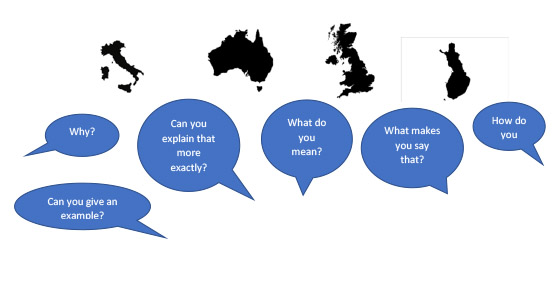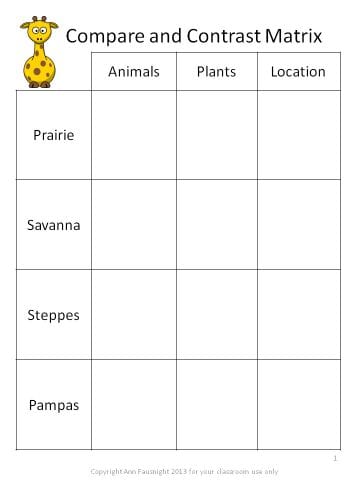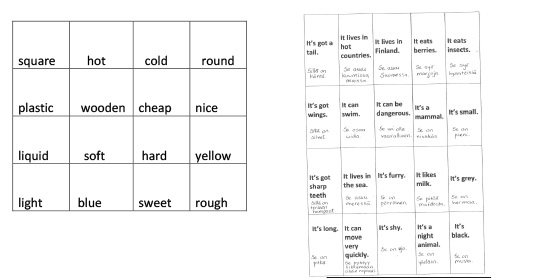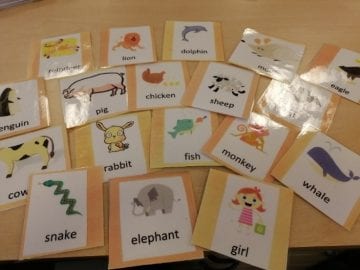Thinking Games
Many different thinking skills can be practiced through thinking games.
It’s often possible to make even small changes to the rules of traditional games so that they no longer depend on chance or luck, but rather on using strategies and on thinking creatively. The games below, and more, are described in these webpages and you can see what kinds of thinking skills they help to develop when altered.
| TRADITIONAL GAME based on… | THINKING GAME based on… | |
| Yes / No Game (See in ACTS tools) | guesswork, speed | challenge, finding the most relevant features, strategy, evaluation and improvement of game |
| Odd Man Out | guesswork, competition, one single answer correct | limitations, making thinking visible, strategy, different answers possible, justifications, evaluation |
| Password / Alias | quick description | finding the most relevant features, making the thinking visible, evaluating and justifying. |
| Which is better? | A simple answer is enough | Giving opinions, giving reasons, listening, questioning, seeing new points of view, changing your mind |
| Which would you rather be? | A simple answer is enough. | Justifying opinions, listening to different points of view, questioning |
The actual subject matter used in these games could be anything and could easily be used to practise / test / revise any topic being dealt with at school.
While playing these games thinking skills and working skills can also be discussed and evaluated using the clouds and wall sentences.
These games can only start to develop thinking skills if they are played in a particular way, and the game facilitator plays an important role here.
Sources:
http://www.thinking-approach.org/other/thinking-games
http://www.thinking-approach.org/yes-no-technology
Jason Buckley (2011), Thinkers’ Games. Making Thinking Physical. Chelmsford: The Philosophy Man Ltd
Robert Fisher (1997), Games for Thinking. Oxford: Nash Pollock Publishing
NOTES FOR THE TEACHER ON PLAYING THINKING GAMES
Thinking time! Pupils need time to think. The teacher can’t expect the pupils to answer immediately and has to be ready to wait for suggestions to come
Pupils have to learn to look at the person who is speaking, and not at the teacher, and they have to listen carefully. This makes it easier for them to participate in the conversation and ask their own questions.
Everyone takes part! Pupils should first have the chance to practise giving their own opinion and justifying it in pairs or small groups. In this way everyone has a chance to speak, even if they don’t all speak to the whole class.
Remember follow-up questions! There are not right and wrong answers. Alternative answers can be given / accepted. Remember to ask the pupils the reasoning behind their answers, ‘Why do you think this?’, ‘Why is this so?’, ‘What makes you think so?’
The teacher’s neutral expression when listening to pupils’ answers and thinking is important.
Evaluation discussion afterwards – on both the task or game and on working skills. Positive feedback!
IMPORTANT WAYS OF WORKING
Pair work: pupils have to learn to cooperative constructively with each other in pair work. This can be practiced separately and pupils can be reminded of the importance of good pair work before it starts – pair work is working together, not just side by side. Working skills connected to pair work can be found in the ACTS wall sentences. The aims and advantages of pair work can also be made visible on the classroom wall like this, for example:
Practise listening well to each other
Allow your partner to talk
Investigate / Inspire each other!
Reason / Reflect
Sort
Think – pair – share: this works well for many types of discussion. It allows time for thinking and lets everyone participate. It has the following steps:-
- Think: first, there’s time to think alone (eg 2 minutes),
- Pair: after that pupils share their thinking with a partner (eg 2minutes)
- Share: finally, there’s a whole class discussion on the issue. Often at this stage the teacher, or a pupil/pupils record the thoughts / points discussed, so that they can be returned to later.
Odd Man Out
Aim:
- giving different reasons for why something is the odd man out
- finding different ways of grouping and classifying things
Materials: words, pictures, objects. For example, a certain number (4 – 5) of jobs, vehicles, fruits etc. Content from different school subjects could be used for this game, thereby also testing knowledge of the subject.
Instructions:
- Decide which of the four is the odd man out and give a reason why it doesn’t belong.
- This becomes more challenging when limitations are introduced, for example, by taking each item at a time and giving a reason for why each could be the odd man out. Another challenge is to find how many different reasons can be found for one item not belonging.
- This practises finding various features of items, noticing similarities and differences and becoming aware of different points of view.
Examples
Which is the odd man out and why?

OR
BRANCH LEAF ROOT FLOWER
Take one item at a time and explain why it is the odd man out.
OR
ODD MAN OUT

Odd Man Out is a good opportunity to practice asking follow-up questions after hearing the reasons given. Both the teacher and the pupils can ask these.
These questions are important when we want to check that the reasoning given is clear and well explained. Some of these questions can also lead to fact checking and to further investigation of a subject.
Password / Alias
Aim:
- Explaining and describing things clearly and exactly
- Making descriptions which are relevant and appropriate to a particular situation
Instructions:
- The basic idea is the same as the Alias game. In this game the pupil has to consciously think about how to describe a word / an object / a picture / an issue well, so that someone else would recognize it without seeing it. They have to notice what makes a description good and relevant, and why parts of the description might be irrelevant. Through this reflection pupils learn to play better.
- One pupil comes to the front of the class and stands with their back to the blackboard.
- The teacher (or another pupil) writes a word (or puts a picture…) on the board.
- The other pupils offer sentences which describe the word (or picture), but they mustn’t mention the word itself.
- The pupil at the front guesses the word.
The teacher can use this game to help develop thinking skills by taking the following steps:
- Write the pupils’ descriptions / sentences on the board while they are playing.
- Reflect! Once the pupil at the front has guessed the word, the teacher asks, ‘Which sentence helped most? Why? Were there any sentences which didn’t help at all, and why?’
- Create limitations! For example, decide in advance how many sentences the pupils are allowed to offer – either as many as possible (though all of them must be true), or as few as possible. If the pupil at the front can’t guess the word, can the class think up a ‘superclue’ to help? If the word is very easy to describe, limitations might be that certain words cannot be used in the descriptions. For example, if the word is ’bird’, they mustn’t use the words, ’fly’, ’wing’ or ‘nest’.
- Alternatives: a) One pupil against the class. b) Pairs or groups think up sentences to describe a particular word / picture / object. The other pairs or groups have to guess what it is. c) Pupils play the whole game in groups.
- Help pupils to play better! Help pupils to notice what is relevant and help them to play more systematically. They should learn not to say just any sentence, but to think of a sentence that is helpful.
- Sort the sentences! Pupils sort the sentences they have suggested for a particular word in as many ways as they can and give the groups they think up names. This shows the pupils particular features of a word or object. For example, if the sentences are related to a particular animal, one of them might be,’ It eats cheese.’ In this case the group name would relate to the feature, or parameter, ‘food’.
- Make a passport, in which the parameters are listed. Next to each parameter the pupils write the sentences related to it. If the parameter is ’Colour’, The sentence might be, ’It is grey.’ This creates a table which can be used to help make a description of any animal. Columns can be added so that different animals can be compared.
- Use the passport as a tool when playing the game. In other activities the passport can be used to help pupils to notice that different parameters are important in different situations . For example, which would be the most important parameters if we wanted to describe a dog in order to sell it? Which would be the most important if you were describing to a friend why your dog is the best dog in the world?
- Reflect! In which situations could the passport work well? When might it not be useful? Is anything missing from it? It can be continually changed and improved.

Magic Cards
Aim:
- pupils notice the different features of things
- pupils develop creative thinking
Materials: The magic cards, or pictures, show, for example, animals or adjectives. Cards can be made with words or pictures related to themes in a particular school subject.
Instructions:
- Pupils work in pairs or groups.
- They lay the cards face down on the table.
- The first pupil takes a card. It says, for example, ‘It can swim.’
- The pupil then has to say the name of an animal which can swim.
- The next pupil takes a card. It says, for example,’ It can be dangerous.’.
- The pupil then has to think of an animal which swims and is dangerous.
- The next pupil takes a card, and it says, for example, ‘It lives in Finland.
- This pupil has to think now of an animal which can swim, is dangerous and lives in Finland.
- The game continues in this way until a pupil can no longer think of a suitable animal.
- A new round begins.
Examples of cards:
With the adjective cards pupils have to think of objects or things which can be described by the adjective on the card. For example, if the card says, ’wooden’, the pupil might say ‘a door’. If the words are then ‘small’ and ‘wooden’, he might say ‘a pencil’, and so on.

Which would you rather be?
Aim:
- giving reasons for your opinion and practicing creative thinking
- practising discussion with partner and good listening
- noticing different points of view
Materials: for example, animal cards
Instructions:
- the teacher can show the pupils an example of how to play first
- each pupil is given an animal card. The remaining cards are left, face-down, on the table.
- pupils walk around the class always changing partners after a discussion.
- they show each other their cards and discuss as shown below
Each in turn gives reasons why they would rather be the animal they have than be their partner’s animal. Alternatively, they could explain which of the two animals they would rather be and why.
Pupils try to think of as many good reasons as possible. When their discussion is over, they take their cards to the table, lay them face down and take a new card. Then they have the same kind of discussion about the new animal (s) with a new partner. The game continues in this way until the teacher stops it.
When the game is over the whole class can discuss, for example, what animal they would like to be and why. The teacher can ask follow-up questions – why would it be better to be bigger / stronger? / What makes you say that? / How do you know that? / Would this always be best?
There could also be a discussion about what is and isn’t a good reason and why.
Cards on any subject or theme could be
used, and can practise subject content
at the same time as playing.
For example, historical figure, countries…

Dividing lines
Aim:
- giving reasons for an opinion
- discussion in groups
- careful listening and possible changing of opinion
Materials: tape for floor
Instructions:
The teacher makes two parallel lines on the floor with tape – they should be about 1 -2meters apart.
- The teacher asks the pupils for example, ‘Which are better, cats or dogs? Stand behind this line if you choose dogs and stand behind that line if you choose cats.’
- It’s important that the pupils look at each other and not at the teacher. A pupil might choose to stand in the middle – this is acceptable, but he / she must be ready to give reasons this choice.).
- Pupils have a few minutes to discuss their choice in their own ’groups’ (dogs together and cats together). They should discuss for example why they think dogs are better than cats. (If there are many pupils on one side, they can be divided into smaller groups).
- After this the pupils stand opposite each other behind their lines, and one (a possible spokesperson), or some, explain to everyone why they made their choice. Alternatively each pupil can speak to one or several on the opposite side. The other side also gives its arguments. After that they can ask each other questions
- After this discussion everyone has the chance to change sides, if, after hearing all the reasons, they want to change their minds.
This can then be continued with new subject matter. The topics can also be related to themes being studied. The themes below are simple, to let the pupils practise reasoning, listening and discussing simple issues and opinions first.
Some suggestions: Which is best?
Dogs or cats? Homework or no homework?
Ice-cream or chocolate? Town or country?
Summer or Winter? Autumn or Spring?
Sweet or sour?
Sorting game
Aim:
- sorting the same material into different types of groups
- explaining reasoning for groupings
Materials: selections of pictures, objects, words, sentences…
Instructions:
- players are given a selection of pictures (or objects, words, or sentences…)
- the players can work individually or in pairs or groups
- they put the pictures (or objects…) into groups and give reasons why they have sorted them in this way.
- the same pictures (objects, words…) can then be sorted again, but in a different way.
Groups can have a competition to see which group can find the most ways of sorting the same pictures (objects, words…) and are also able to explain the thinking behind the sorting. In this way pupils practise sorting (classifying), reasoning, finding similarities and differences between things and noticing different points of view.
The materials used can relate directly to school subject matter.

